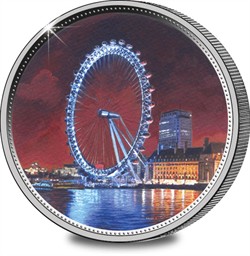-no-button.jpg)
 |
Location: South Bank of the River Thames,
London
Date completed: Officially opened 31st
December 1999 (open to public 7 March 2000)
Designers: Original concept, David Marks and
Julia Barfield
Function: Ferris Wheel
|
Normally, landmarks take centuries to establish themselves in
the regard of the public. The London Eye has become an iconic part
of London's cityscape despite operating only since 2000. The London
Eye is a giant Ferris wheel, the biggest in the world at the time
of its launch. It carries passengers in 32 specially designed
capsules, each air conditioned and sealed, weighing 11 tons and
carrying up to 25 people. Located on the South bank of the Thames,
the London Eye is 443 ft (135 m) tall and offered the highest
vantage point in London until surpassed by the observation deck of
the Shard. Despite the construction of other taller Ferris wheels
around the world, it remains the biggest in Europe and claims to be
the largest cantilevered observation wheel (the larger Ferris
wheels are supported by double 'A' frames). The wheel rotates at a
leisurely 0.26 m per second (0.6 mph/0.9 km hr) - twice as fast as
a tortoise!), so a complete rotation takes 30 minutes. The capsules
are maintained in the horizontal position by computers that
activate tilt switches when necessary. On a clear day, passengers
can see for 25 miles (40 km) - as far as Windsor Castle to the
West.
The London Eye was the brainchild of David Marks and Julia
Barfield, who were a husband and wife architectural team. It took
seven years and the skills and products of six countries to make
their vision a reality. The pre-fabricated components of the
structure were delivered to the site along the River Thames and the
wheel was assembled lying flat on piled dolphins sunk into the
river. Once complete it was lifted into an upright position in two
phases at the rate of 2 cm per hour. It was finally secured in a
vertical position on 11th October 1999. The final capsule was
fitted on 11th November. The London Eye was officially opened by
then Prime Minister Tony Blair on 31st December 1999, although due
to technical problems it was not opened to the public until 9th
March 2000. Today it is the most popular paid-for visitor
attraction in the UK.